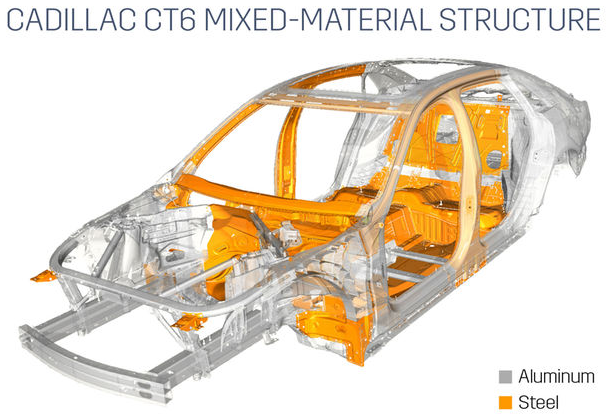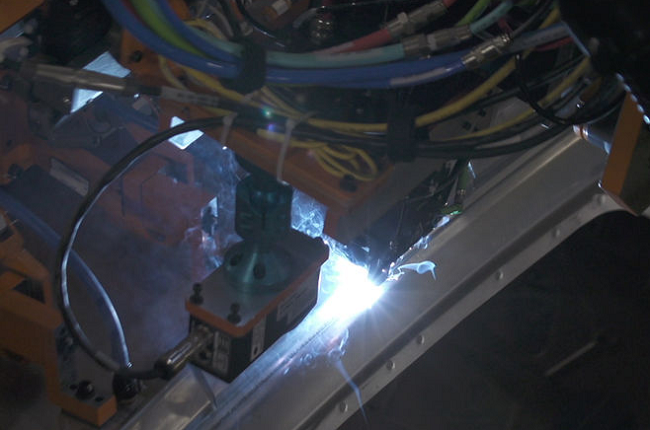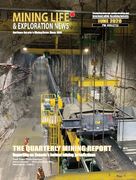War of Ideas: GM’s Mixed-Material Strategy vs. Ford’s Bet on Aluminum
Two approaches to lighter, more fuel-efficient vehicles

Ford made headlines when it gutted body shops at two pickup truck plants to build the new 2015 F-150 with an aluminum body instead of heavier steel, convinced the cost and risk were worth it for a lighter and better truck. General Motors is equally committed to reducing the weight of future vehicles but has taken a different approach. It quietly pursued ways to use existing body shops, tools, and equipment to spot weld future vehicles with a mix of materials, including aluminum — a strategy deemed less costly and disruptive.
After years of development and testing, engineers at GM are on the verge of putting a couple parts for the Cadillac CT6 sedan into production that are notable because they require welding steel to aluminum. GM is only months away from assembling seat backs and hood reinforcements using spot welding to join the two metals.
It is potentially a game-changer for an industry seeking the fastest and cheapest way to make lighter, more fuel-efficient vehicles. Others have expressed interest in GM’s technology. Ford’s strategy, so far, is not being emulated by others.

It might not sound sexy but making cars and trucks comes down to mating metal. When you think of an auto plant, the image that comes to mind is robots and sparks flying as they spot weld steel parts to form the body and frame of a new automobile. The growth of aluminum in vehicles posed manufacturing challenges on the plant floor. GM tested the water when it put an aluminum liftgate on a Tahoe hybrid in 2008 and tested its ability to do aluminum-to-aluminum spot welding. Today it is a manufacturing staple at GM, but it took eight years for these spot welds to become mainstream, said Blair Carlson, Lightweight Material Processing Lab Group Manager.
Next up: applying spot welding — which is quicker and cheaper, and plants are already set up to do it — to the joining of steel and aluminum. GM will start with parts on the CT6 and Carlson is optimistic it won’t take another eight years for this latest advance to become mainstream practice at GM. The challenge was that at 655 degrees Celsius aluminum is molten whereas steel is just starting to warm up — it needs 1,538 degrees to melt. And where the two layers of hot metal meet, a glassy layer forms that is brittle. GM has found a way to pulse currents through the two metals in a way that heats and cools them to keep that layer thin, said David Sigler, a technical fellow at GM.
The ability to spot weld just about anything has the potential to save millions of dollars because the work can be done in existing body shops with current tools. “Brick and mortar is a high investment,” said Carlson.

Ford spent millions to be able to manufacture aluminum-bodied pickups after seven decades of making a steel truck. To make the switch Ford closed its Dearborn Truck Plant in August 2014 to demolish the body shop and build a new one with robots and tooling designed to work with aluminum. Months later, when the plant reopened, Ford repeated the exercise at its Kansas City, Mo., plant.
Ford spent $359 million ripping up Dearborn Truck, another $484 million at the adjacent Diversified and Stamping facilities, and $1.1 billion at the Kansas City plant. Months of downtime were followed by a slow launch of the company’s most profitable vehicle. Revenue took a $2 billion hit in the first quarter of 2015 due to heavy launch costs and F-150 volume was down by 60,000 trucks worth about $40,000 each.
It also took a toll on Ford’s reputation. Critics questioned the wisdom of the move which impacted profitable inventory for a year. Ford officials say strong sales of the profitable trucks, which shed 700 pounds, prove the upheaval and risk were worth it. And the lessons learned will be applied to more vehicles including the SuperDuty pickup and next-generation Ford Expedition and Lincoln Navigator full-size SUVs.
GM’s Carlson said Ford’s strategy works in a dedicated plant like Dearborn that only makes pickups. But GM wants the flexibility to weld different metals for a new vehicle even if there is another vehicle in the plant that does not need it. GM is expected to incorporate a lot more aluminum in its next generation of pickups in 2018, but they will still rely on advanced steels, making the mixed-material welding capability key.

With the technology to weld aluminum to steel, GM can reduce mass by joining an aluminum roof to a steel structure, for example, said Warren Parsons, Chief Architect-Body Structures. Greater use of welding reduces the need for rivets which add a surprising amount of weight and up to $100 per vehicle in extra cost.
In the pecking order of new materials by weight, compared with conventional steel, advanced steel is 20 percent lighter, composites 25 percent lighter, aluminum 40 percent lighter, magnesium 50 percent lighter, and carbon fiber is 55-65 percent lighter, said Mark Verbrugge, Director of Research & Development in GM’s Chemical and Material Systems Labs.
GM is also working with more magnesium. It can be found on the seats in the Chevrolet Corvette, on steering wheels, and is finding its way into door panels. A seven-part steel inner door panel can be replaced with a single casting weighing half as much, said Anil Sachdev, Light Metals Systems Lab Group Manager. It is not yet in production as GM studies where best to use it and how to address its higher cost.
Another project is looking at carbon fiber wheels as an alternative to aluminum. But careful execution and design are required because carbon fiber is such a complex material and engineers are still working to understand how it performs. The potential is a lighter but stiffer wheel for better driving dynamics and which is more resistant to damage. GM expects carbon fiber wheels will find their way to production vehicles, but there are still some bugs to work out.
Source: http://www.motortrend.com/news/war-ideas-gms-mixed-material-strategy-vs-fords-bet-aluminum/

|